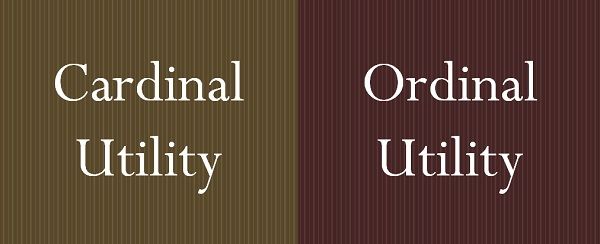 The utility is a psychological phenomenon; that implies the satisfying power of a good or service. It differs from person to person, as it depends on a person’s mental attitude. The measurability of utility is always a matter of contention. The two principal theories for the utility are cardinal utility and ordinal utility. Many traditional economists hold the view that utility is measured quantitatively, like length, height, weight, temperature, etc. This concept is known as cardinal utility concept.
The utility is a psychological phenomenon; that implies the satisfying power of a good or service. It differs from person to person, as it depends on a person’s mental attitude. The measurability of utility is always a matter of contention. The two principal theories for the utility are cardinal utility and ordinal utility. Many traditional economists hold the view that utility is measured quantitatively, like length, height, weight, temperature, etc. This concept is known as cardinal utility concept.
On the other hand, ordinal utility concept expresses the utility of a commodity in terms of ‘less than’ or ‘more than’. Take a read of the article to know the important differences between cardinal and ordinal utility.
Content: Cardinal Utility Vs Ordinal Utility
Comparison Chart
| Basis for Comparison | Cardinal Utility | Ordinal Utility |
|---|---|---|
| Meaning | Cardinal utility is the utility wherein the satisfaction derived by the consumers from the consumption of good or service can be expressed numerically. | Ordinal utility states that the satisfaction which a consumer derives from the consumption of good or service cannot be expressed numerical units. |
| Approach | Quantitative | Qualitative |
| Realistic | Less | More |
| Measurement | Utils | Ranks |
| Analysis | Marginal Utility Analysis | Indifference Curve Analysis |
| Promoted by | Classical and Neo-classical Economists | Modern Economists |
Definition of Cardinal Utility
The notion of Cardinal utility was formulated by Neo-classical economists, who hold that utility is measurable and can be expressed quantitatively or cardinally, i.e. 1, 2, 3, and so on. The traditional economists developed the theory of consumption based on cardinal measurement of utility, for which they coined the term ‘Util‘ expands to Units of utility. It is assumed that one util is equal to one unit of money, and there is the constant utility of money.
Further, it has been realised with the passage of time that the cardinal measurement of utility is not possible, thus less realistic. There are many difficulties in measuring utility numerically, as the utility derived by the consumer from a good or service depends on a number of factors such as mood, interest, taste, preferences and much more.
Definition of Ordinal Utility
Ordinal Utility is propounded by the modern economists, J.R. Hicks, and R.G.D. Allen, which states that it is not possible for consumers to express the satisfaction derived from a commodity in absolute or numerical terms. Modern Economists hold that utility being a psychological phenomenon, cannot be measured quantitatively, theoretically and conceptually. However, a person can introspectively express whether a good or service provides more, less or equal satisfaction when compared to one another.
In this way, the measurement of utility is ordinal, i.e. qualitative, based on the ranking of preferences for commodities. For example: Suppose a person prefers tea to coffee and coffee to milk. Hence, he or she can tell subjectively, his/her preferences, i.e. tea > coffee > milk.
Key Differences Between Cardinal and Ordinal Utility
The following points are noteworthy so far as the difference between cardinal and ordinal utility is concerned:
- Cardinal utility is the utility wherein the satisfaction derived by the consumers from the consumption of good or service can be measured numerically. Ordinal utility states that the satisfaction which a consumer derives from the consumption of product or service cannot be measured numerically.
- Cardinal utility measures the utility objectively, whereas there is a subjective measurement of ordinal utility.
- Cardinal utility is less realistic, as quantitative measurement of utility is not possible. On the other end, the ordinal utility is more realistic as it relies on qualitative measurement.
- Cardinal utility, is based on marginal utility analysis. As against this, the concept of ordinal utility is based on indifference curve analysis.
- The cardinal utility is measured in terms of utils, i.e. units of utility. On the contrary, the ordinal utility is measured in terms of ranking of preferences of a commodity when compared to each other.
- Cardinal utility approach propounded by Alfred Marshall and his followers. Conversely, ordinal utility approach pioneered by Hicks and Allen.
Conclusion
These two above mentioned demand analysis approaches are not in competition with each other, but during the analysis of consumer behaviour, they represent two levels of sophistication. Both cardinal and ordinal utility are vital to assess and analyse consumer demand for a good or service, irrespective of the purpose.






Sajid Mehmood says
it was helpful
Pratik says
Thanks Surbhi, now I understand the differences between them.
Subhashree says
Thank u very much for this….
But I have a question that which utility approach is treated to be a better tool to analyze consumer behaviour…..
Anjali Brahma says
Thank you so much sir.
Aditya Gona says
Very helpful for ISC students as this question is there in the syllabus but not given in the text book
Kishor says
Thanks for easy expressing
Alex siliako says
thanks for that bud I would like to ask, What are the similarities of those two approaches
Abdullah Iqbal says
good
Sanni Umar farouq says
That true